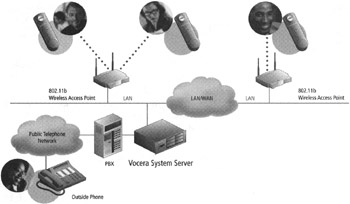Devices
|
| < Day Day Up > |
|
Wi-Fi capability has been provided, for the most part, via add-ons to existing computing devices, e.g. PC card (for a laptop), PCI card (for a PC), smart card (for a PDA or cell phone). This current situation is quickly changing, however. Devices made specifically for Wi-Fi are becoming easier and easier to find. In fact, it won't be long before Wi-Fi technology shows up in just about anything that uses information and has a battery or fuel cell: cell phones, GameBoys, MP3 players, Walkmans, watches, automobiles, and on and on. Such universal availability should aid Wi-Fi in its march toward universal acceptance.
Wi-Fi has even gone the wearable route! Vocera Communications is merging telephone networks with Wi-Fi's ability to deliver data over short ranges. The company has teamed with chipmaker Intersil to create a two ounce rectangular "badge" that can be worn on the user's clothing, preferably close to the face (e.g. collar or sleeve). Since the badge enables instant two-way voice conversation without the need to remember a phone number or manipulate a handset, it can replace the bulky handsets used by most within the target market. This new breed of phone network uses Wi-Fi to provide hands-free, voice-activated communications throughout any 802.11b networked building or campus and, in doing so, provides instant two-way voice communications within that environment.
The Vocera Communications system is made up of two elements: the Vocera Server Software and the Communications Badge.
The Vocera Server Software runs on a standard Windows 2000 server and houses the centralized system intelligence-the Call Manager, User Manager, and Connection Manager programs as well as speech recognition software and various kinds of database software.
The Vocera Communications Badge is controlled using natural spoken language. To initiate a conversation with two people, say, Steve and Madelyn, the user would simply say, "Get me Steve and Madelyn." On those occasions when a live conversation is not necessary, text messages and alerts can be sent to the LCD screen on the Communications Badge.

Figure 3.4: Vocera Communications Network Diagram. Graphic courtesy of Vocera Communications.

Figure 3.5: The badge on the right shows the speaker and the badge on the left displays the LCD screen.
The famous American chain store, Target, is outfitting its retail outlets with a Vocera system and Disney World has the technology under consideration as a way to allow parents keep track of their children when visiting its theme parks. Also, don't be surprised if you find a Vocera system in use in healthcare facilities, where the transmissions of traditional cell phones might interfere with the operation of certain medical equipment. In fact, the Vocera system has been successfully trialed in a San Francisco healthcare facility.
Computing Devices
Apple, operating well ahead of the curve on Wi-Fi, has been integrating wireless connectivity into its computers for years. In fact, Apple should be given credit for helping to establish 802.11 as the de facto standard for wireless networking.
Today, however, there really is no clear market leader. Most major notebook/laptop computer makers have followed Apple's lead, shipping products with embedded 802.11 NICs (Network Interface Cards). This means that it's incredibly inexpensive for the end-user to enjoy Wi-Fi services. For example, Fujitsu's Lifebook and its 3COM wireless NIC (also known as a wireless adapter) are making a strong showing in an ever more crowded market of Wi-Fi-enabled notebook computers. And, by the time you read this book, Dell will have reached its goal of Wi-Fi-enabling all of its laptops. IBM, HP-Compaq and Sony are also jostling for a leadership position.
There are essentially two methods by which notebook/laptop computers are Wi-Fi-enabled: embedded and attached.
Embedded: Two prime examples of embedded Wi-Fi solutions are IBM's ThinkPad A31 and Toshiba's Satellite Pro 4600. But soon all computing devices will have embedded Wi-Fi capabilities, at least if Intel has its way.
Attached: In the past, the most popular method to give a portable computing device Wi-Fi ability is to add an adapter card. Inexpensive PC Card-based adapters from Dell, Compaq and others account for most of the legacy base of notebooks/laptops with 802.11 functionality.
Notebooks and laptop computers aren't the only computing devices sporting Wi-Fi capabilities:
-
At the industry's 2002 Comdex show, HP introduced its iPaq (a small PDA-like device). This little unit offers a color screen along with its built-in Wi-Fi and Blue-tooth connectivity. It even features a universal remote for home and office electronics!
-
Toshiba's e740 PDA supports Wi-Fi right out of the box.
-
Microsoft's new Tablet PC comes with built-in Wi-Fi.
-
HP also offers a Wi-Fi-enabled printer.
-
A wireless netcam is available from D-Link.
That's just the tip of the iceberg. The increase in Wi-Fi-enabled devices (computing and otherwise), along with manufacturers providing smaller, faster and cheaper devices, will drive demand for Wi-Fi access, in a variety of arenas, worldwide.
|
| < Day Day Up > |
|
EAN: 2147483647
Pages: 273
- ERP Systems Impact on Organizations
- The Second Wave ERP Market: An Australian Viewpoint
- Context Management of ERP Processes in Virtual Communities
- Healthcare Information: From Administrative to Practice Databases
- Relevance and Micro-Relevance for the Professional as Determinants of IT-Diffusion and IT-Use in Healthcare